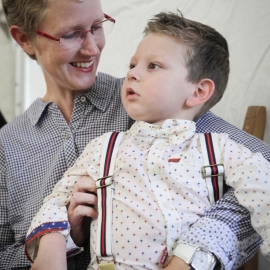MCT8 - AHDS Foundation
Guidelines for physicians caring for patients with MCT8-AHDS abnormalities
1. Genetic Confirmation
All patients with suspected MCT8 abnormalities based on clinical presentation: X-linked mode of inheritance (i.e. virtually all affected individuals are males); neurodevelopmental abnormalities present during infancy or early childhood. Thyroid function tests may be abnormal (classically high T3 and low reverse T3, slightly low or low normal T4 and normal or slightly high TSH). Thyroid tests may also be normal in mild cases.
Genetic confirmation of MCT8 abnormality of propositus. For a proper genetic counseling, it is recommended that also parents and siblings should be tested for MCT8 abnormalities.
2. Initial evaluation at time of diagnosis and follow up
-
Metabolic
-
Basal metabolic rate
-
Growth measurements at birth and yearly for 4 years (weight, height, head circumference). Make note of any scoliosis
-
Bone densitometry with whole body composition analysis
-
Comprehensive metabolic panel
-
Growth hormone, IGF1
-
Skeletal muscle markers: CPK, aldolase
-
Calorie count
-
Thyroid function tests (free and/or total T4, T3, TSH, rT3, TG, antibodies to TPO and TG) and any previous thyroid tests.
-
thyroid ultrasound
-
Lipid panel
-
Thyroid action markers especially during thyromimetic/antithyroid treatments): SHBG, ferritin, cholesterol
-
Neurologic
-
MRI of brain “standard” plus DTI/DKI sequences
-
CSF for measurement of thyroid hormones and medications
-
Physical examination semi-annually until 3 years then annually noting:
-
dysmorphic features
-
cognitive regression
-
presence or absence of clonus; DTR’s (pathologic reflexes: jaw jerk, Babinski, etc
-
presence or absence of seizures and type; EEG if history of seizure and follow up EEG prn
-
presence or absence of normal/hypotonic/spastic muscle tone
-
-
Strength, movement disorder (chorea, athetosis, dystonia)
-
Swallowing study
-
Sleep study with EEG recording
-
Hearing test (auditory evoked responses)
-
Speech test
-
Visual evoked responses
-
Activity monitor (actiwatch)
-
Bayley or some modified test (visual tracking; head lag; ??)
-
(Denver II?; McCarthy?, Stanford-Binet, etc.?...need psychologist with experience testing children with significant neurodevelopmental delays to pick the best testing
-
Cardiovascular
-
Sleeping Pulse
-
blood pressure and orthostatic measurements
-
Pulmonary
-
Measurements of inspiratory and expiratory capacities
-
pulse oximetry measurement
-
history of pulmonary infections
-
Endocrine
-
Thyroid tests as above
-
steroid hormone levels
-
Gastrointestinal
-
presence or absence of vomiting
-
presence or absence of reflux
-
presence or absence of constipation
-
presence or absence of tube feeding, what type, what tube feeds
3. Initial management
A. Symptomatic Treatment (from UPTODATE)
-
Current treatment options for patients with MCT8 gene mutations are limited to supportive measures, including the use of braces to prevent contractures.
-
Diet is adjusted to prevent aspiration. Gastrostomy could be recommended if nutritional problems, dysphagia or aspiration occur. Nutrition experts should intervene in this area of problem. Swallowing rehabilitation could be also useful in some cases.
-
Spasticity treatment could be managed following guidelines for cerebral palsy because specific knowledge is lacking (Neurology 2010 74(4):336-43, PMID: 20101040 or Eur J Neurol 2010 17(S2):9-37 PMID: 20633177)
-
Dystonia could be treated with anticholinergics, L-DOPA, carbamazepine, and baclofen.
-
Drooling may respond to treatment with glycopyrrolate or scopolamine or botulinum toxin
-
Seizures are treated with standard anticonvulsants based on seizure type, etc. (avoid those anti-convulsants that have hypotonia/sedative/and other CNS side effects).
B. Non-pharmacologic therapy
-
physical therapy: Physical therapy, stimulation and therapeutic occupational exercises should be provided. Parents report that music and water activities are particularly joyful and useful for these patients.
-
occupational therapy
-
speech therapy
C. Longer term treatment (enrollment in a clinical trial)
-
DITPA
-
TRIAC
-
T4 and PTU
D. Whom to Contact for further information and availability of the above medications:
-
United States: Refetoff/Dumetrescu/Weiss
-
Europe: Visser (but need physician contact)
-
Asia:
-
Middle East:

